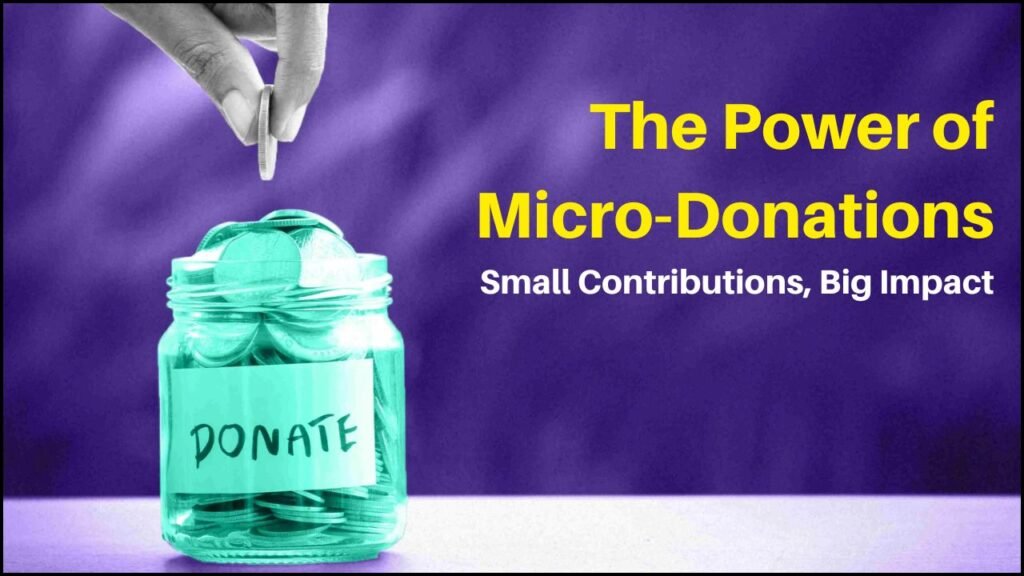
Micro-donations are creating a silent revolution in the world of giving. Small financial contributions, often just a few rupees, are adding up to create enormous social change. These donations are not just helping the needy but also building a culture of regular giving among people who once believed only big donations mattered. With digital platforms, mobile apps, and crowdfunding tools now common, giving has never been easier, faster, and more inclusive.
Micro-Donations: Details
Micro-donations are small contributions made to support charitable causes. These can be as little as Rs 5 or Rs 10, but when collected from many people, they become powerful.
- Affordable Giving – Allows people of all income levels to donate.
- Daily Acts – Can be done while shopping, ordering food, or using apps.
- Collective Strength – When combined, these donations help build schools, feed families, or support medical treatments.
Examples of Micro-Donations in Daily Life
| Activity | How Donation Happens |
|---|---|
| Ordering Food | Adding ₹1–₹5 to your Zomato or Swiggy order for charity |
| Shopping at Malls | Choosing to donate change while paying at billing counters |
| Online Payments | GPay/Paytm donation links during disasters or campaigns |
| Crowdfunding Sites | Small payments made on platforms like Ketto or Milaap |
The Rise of Micro-Donations
Micro-donations have changed the giving landscape. They are no longer rare or occasional but part of everyday life.
Engaging a Broader Audience
- Inclusive for All – Everyone can contribute, from students to senior citizens.
- Disaster Relief – During floods or earthquakes, small donations from millions of people help provide food, shelter, and medicine.
- Youth Involvement – Millennials and Gen Z are more likely to donate through quick, online options.
Convenience
Technology has made donating simple and quick.
- Digital Platforms – Apps and websites make donating just a few taps away.
- Cashless Giving – No need for cash or big cheques—just a mobile phone is enough.
- Recurring Options – Many platforms offer auto-donate features where a set amount is given monthly.
Creating a Culture of Giving
Micro-donations encourage people to give regularly rather than occasionally.
- Social Media Influence – Campaigns like #DonateYourChange or #Give10 often go viral, motivating others.
- Peer Impact – Seeing friends donate encourages others to join.
- Storytelling – Real-life stories shared on social media inspire empathy and action.
Accessibility and Inclusivity
Micro-donations remove financial barriers, making everyone feel they can contribute.
| Donor Type | Usual Donation Amount |
|---|---|
| College Student | Rs 5–Rs 20 |
| Homemaker | Rs 10–Rs 50 |
| Working Professional | Rs 50–Rs 200 |
| Senior Citizen | Rs 10–Rs 100 |
Supporting Diverse Causes
People can support causes that match their values or interests.
- Education – Donations to build classrooms or buy school supplies.
- Health – Helping patients afford surgery or medicine.
- Environment – Planting trees or protecting endangered species.
- Animal Welfare – Feeding or treating injured animals.
Transparency and Accountability
Trust is a big part of giving, and digital tools help build that trust.
- Receipts – Instant receipts are emailed after donations.
- Progress Updates – Donors get photos, videos, and reports on how their money is used.
- Live Campaigns – Real-time counters show how many people donated and how much has been raised.
NGOs Making a Difference
One such example is Bal Raksha Bharat (Save the Children India).
- Mission – To ensure every child gets proper education, healthcare, and protection.
- Programmes – Mid-day meals, learning centres, health camps, child protection networks.
- Impact – Thousands of children across India have access to better opportunities and a safe future.
How Your Rs 10 Can Help a Child
| Donation Amount | What It Supports |
|---|---|
| Rs 10 | One nutritious snack for a child |
| Rs 50 | One learning kit with pencils and notebooks |
| Rs 100 | One health check-up for a child |
| Rs 500 | One week of schooling in a bridge centre |
Why Micro-Donations Matter
- Scalable Impact – A single small donation may not seem like much, but when multiplied by thousands or lakhs, it becomes powerful.
- Community Power – Everyone contributes together toward a shared goal.
- Personal Connection – People feel involved and part of the solution.
How to Get Started
- Pick a Cause – Choose what matters to you: children, animals, environment, education.
- Choose a Platform – Trusted sites include GiveIndia, Ketto, Milaap, and NGO websites.
- Set a Budget – Decide on a monthly micro-donation amount (e.g., ₹50).
- Share the Message – Inspire others by posting about your donation journey.
FAQs
What is the meaning of micro-donation?
A micro-donation is a small amount of money given for a charitable cause, often ranging from a few rupees to Rs 100.
Why are micro-donations important?
Micro-donations make giving easy, inclusive, and powerful when combined with others’ donations.
How can I make a micro-donation?
You can donate through food delivery apps, e-wallets, NGO websites, or crowdfunding platforms.
What is the impact of a ₹10 donation?
Even Rs 10 can feed a child, contribute to buying medicines, or help someone access clean water.
Who is a micro-donor?
A micro-donor is someone who gives small amounts regularly to support social causes.
Can micro-donations be tax-exempt?
Yes, donations made to registered NGOs under Section 80G are eligible for tax deductions.









